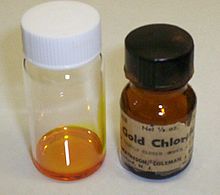 Global Information
Global InformationGold compounds information

Gold compounds are compounds by the element gold (Au). Although gold is the most noble of the noble metals,[1][2] it still forms many diverse compounds. The oxidation state of gold in its compounds ranges from −1 to +5, but Au(I) and Au(III) dominate its chemistry. Au(I), referred to as the aurous ion, is the most common oxidation state with soft ligands such as thioethers, thiolates, and organophosphines. Au(I) compounds are typically linear. A good example is Au(CN)−2, which is the soluble form of gold encountered in mining. The binary gold halides, such as AuCl, form zigzag polymeric chains, again featuring linear coordination at Au. Most drugs based on gold are Au(I) derivatives.[3]
Au(III) (referred to as the auric) is a common oxidation state, and is illustrated by gold(III) chloride, Au2Cl6. The gold atom centers in Au(III) complexes, like other d8 compounds, are typically square planar, with chemical bonds that have both covalent and ionic character. Gold(I,III) chloride is also known, an example of a mixed-valence complex.
Gold does not react with oxygen at any temperature[4] and, up to 100 °C, is resistant to attack from ozone.[5]
Some free halogens react with gold.[6] Gold is strongly attacked by fluorine at dull-red heat[7] to form gold(III) fluoride AuF3. Powdered gold reacts with chlorine at 180 °C to form gold(III) chloride AuCl3.[8] Gold reacts with bromine at 140 °C to form gold(III) bromide AuBr3, but reacts only very slowly with iodine to form gold(I) iodide AuI.
Gold does not react with sulfur directly,[9] but gold(III) sulfide can be made by passing hydrogen sulfide through a dilute solution of gold(III) chloride or chloroauric acid.
Gold readily dissolves in mercury at room temperature to form an amalgam, and forms alloys with many other metals at higher temperatures. These alloys can be produced to modify the hardness and other metallurgical properties, to control melting point or to create exotic colors.[10]
Gold is unaffected by most acids. It does not react with hydrofluoric, hydrochloric, hydrobromic, hydriodic, sulfuric, or nitric acid. It does react with selenic acid, and is dissolved by aqua regia, a 1:3 mixture of nitric acid and hydrochloric acid. Nitric acid oxidizes the metal to +3 ions, but only in minute amounts, typically undetectable in the pure acid because of the chemical equilibrium of the reaction. However, the ions are removed from the equilibrium by hydrochloric acid, forming AuCl−4 ions, or chloroauric acid, thereby enabling further oxidation.
Gold is similarly unaffected by most bases. It does not react with aqueous, solid, or molten sodium or potassium hydroxide. It does however, react with sodium or potassium cyanide under alkaline conditions when oxygen is present to form soluble complexes.[9]
Common oxidation states of gold include +1 (gold(I) or aurous compounds) and +3 (gold(III) or auric compounds). Gold ions in solution are readily reduced and precipitated as metal by adding any other metal as the reducing agent. The added metal is oxidized and dissolves, allowing the gold to be displaced from solution and be recovered as a solid precipitate.
- ^ Hammer, B.; Norskov, J. K. (1995). "Why gold is the noblest of all the metals". Nature. 376 (6537): 238–240. Bibcode:1995Natur.376..238H. doi:10.1038/376238a0. S2CID 4334587.
- ^ Johnson, P. B.; Christy, R. W. (1972). "Optical Constants of the Noble Metals". Physical Review B. 6 (12): 4370–4379. Bibcode:1972PhRvB...6.4370J. doi:10.1103/PhysRevB.6.4370.
- ^ Shaw III, C. F. (1999). "Gold-Based Medicinal Agents". Chemical Reviews. 99 (9): 2589–2600. doi:10.1021/cr980431o. PMID 11749494.
- ^ "Chemistry of Oxygen". Chemwiki UC Davis. 2 October 2013. Retrieved 1 May 2016.
- ^ Craig, B. D.; Anderson, D. B., eds. (1995). Handbook of Corrosion Data. Materials Park, Ohio: ASM International. p. 587. ISBN 978-0-87170-518-1.
- ^ Wiberg, Egon; Wiberg, Nils & Holleman, Arnold Frederick (2001). Inorganic Chemistry (101st ed.). Academic Press. p. 1286. ISBN 978-0-12-352651-9.
- ^ Wiberg, Egon; Wiberg, Nils (2001). Inorganic Chemistry. Academic Press. p. 404. ISBN 978-0-12-352651-9.
- ^ Wiberg, Wiberg & Holleman 2001, pp. 1286–1287
- ^ a b Emery, J. F.; Ledditcotte, G. W. (May 1961). "Nuclear Science Series (NAS-NS 3036) The Radio Chemistry of Gold" (PDF). Oak Ridge, TN: National Academy of Sciences — National Research Council — Subcommittee on Radio Chemistry. US Atomic Energy Commission. Archived (PDF) from the original on 10 November 2004. Retrieved 24 February 2021.
- ^ Jewellery Alloys. World Gold Council


![{\displaystyle {\ce {2 Au + 3 F2 ->[t] 2 AuF3}}}](https://wikimedia.org/api/rest_v1/media/math/render/svg/ff81168773c670f0d20dad637eb11c293eab2ea8)
![{\displaystyle {\ce {2 Au + 3 Cl2 ->[t] 2 AuCl3}}}](https://wikimedia.org/api/rest_v1/media/math/render/svg/2ebb268ed66673aa0145c1c0df0cc4e2190677a0)
![{\displaystyle {\ce {2 Au + 2 Br2 ->[t] AuBr3 + AuBr}}}](https://wikimedia.org/api/rest_v1/media/math/render/svg/e53e90a38d7b2135e56e55c38295b794004fbf80)
![{\displaystyle {\ce {2 Au + I2 ->[t] 2 AuI}}}](https://wikimedia.org/api/rest_v1/media/math/render/svg/3328739b5441258750c0ddcc4ac0bc47ab9316e7)
![{\displaystyle {\ce {2Au{}+6H2SeO4->[200^{\circ }C]Au2(SeO4)3{}+3H2SeO3{}+3H2O}}}](https://wikimedia.org/api/rest_v1/media/math/render/svg/67f8b0b6909b00931fc564c952a576d3447d518b)
![{\displaystyle {\ce {Au{}+4HCl{}+HNO3->H[AuCl4]{}+NO\uparrow +2H2O}}}](https://wikimedia.org/api/rest_v1/media/math/render/svg/b9bf902ad0abbf25dd39223aaba3259238a88467)